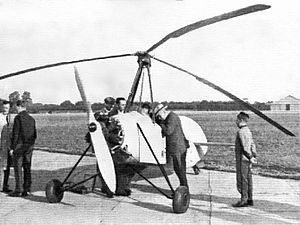Hafner A.R.III Gyroplane
| A.R.III Gyroplane | |
|---|---|

| |
| Hafner AR.III at Heston, 1935 | |
| Role | Experimental autogyro |
| National origin | United Kingdom |
| Manufacturer | A.R.III Construction Company |
| Designer | Raoul Hafner |
| First flight | Autumn 1935 |
| Number built | 1 |
The Hafner A.R.III Gyroplane was a British 1930s experimental autogyro designed by Austrian Raoul Hafner, and built by the A.R.III Construction Company at Denham, Buckinghamshire.[1][2]
Design and development[]
The single-seat Gyroplane had a three-blade auto-rotating rotor fitted above the fuselage on a strutted plyon.[1] A 90 hp (67 kW) Pobjoy Niagara radial piston engine was mounted on the fuselage nose.[1] It had fixed tailwheel landing gear and the rear fuselage included a large dorsal fin to provide directional stability.[2] An unusual feature was the control system which was equipped with spider-actuated cyclic and collective pitch control of the rotor blades; this mechanism, a variant of the swashplate-actuated rotor control, became a standard feature on helicopters.[2] In 1935, the Gyroplane was manufactured at the Martin-Baker Aircraft Company's factory at Denham, Buckinghamshire.[1] In autumn 1935, the Gyroplane, registered G-ADMV, first flew at Heston Aerodrome, piloted by V.H. Baker.[3] On 6 February 1937, it flew at Hanworth Air Park, having been modified as the Mark 2 version. It was tested at Farnborough, and leased to the Royal Aircraft Establishment for research, but it was scrapped during the second world war.[1] A two-seat A.R.IV and three-seat A.R.V were planned, but construction was stopped when Hafner was interned under Defence Regulation 18B.
Variants[]
- A.R.III
- Prototype single-seat autogyro powered by a Pobjoy Niagara radial piston engine.
- A.R.IV
- Experimental rotorcraft to meet Air Ministry Specification S.22/38. Powered by a 210hp de Havilland Gipsy Six II engine, construction was started by Short Brothers as the Fleet Spotter, but was stopped in May 1940 when Hafner was interned.
- A.R.V
- Experimental rotorcraft to meet Air Ministry Specification S.22/38. Powered by a 210hp de Havilland Gipsy Six II engine, construction was started by Short Brothers as the Night Shadower, but was stopped in May 1940 when Hafner was interned.
Specifications[]
Data from [1]British Civil Aircraft since 1919 Volume
General characteristics
- Crew: one
- Length: 17 ft 10 in (5.44 m)
- Empty weight: 640 lb (290 kg)
- Gross weight: 900 lb (408 kg)
- Powerplant: 1 × Pobjoy Niagara , 90 hp (67 kW)
- Main rotor diameter: 32 ft 10 in (10.00 m)
Performance
- Maximum speed: 120 mph (190 km/h, 100 kn)
See also[]
Related lists
References[]
Notes[]
Bibliography[]
| Wikimedia Commons has media related to Hafner A.R.III Gyroplane. |
- The Illustrated Encyclopedia of Aircraft (Part Work 1982-1985). Orbis Publishing.
- Jackson, A.J. (1973). British Civil Aircraft since 1919 Volume 2. London: Putnam. ISBN 0-370-10010-7.
- 1930s British experimental aircraft
- Single-engined tractor autogyros
- Aircraft first flown in 1935